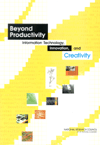
Creativity plays a crucial role in culture; creative activities provide personal, social, and educational benefit; and creative inventions...
The benefits of information technology (IT) extend far beyond productivity as it is usually understood and measured. Not only can the application of IT provide better ratios of value created to effort expended in established processes for producing goods and delivering services, but it can also reframe and redirect the expenditure of human effort, generating unanticipated payoffs of exceptionally high value. Information technology can support inventive and creative practices in the arts, design, science, engineering, education, and business, and it can enable entirely new types of creative production. The scope of IT-enabled creative practices is suggested (but by no means exhausted) by a host of coinages that have recently entered common language—computer graphics, computer-aided design, computer music, computer games, digital photography, digital video, digital media, new media, hypertext, virtual environments, interaction design, and electronic publishing, to name just a few.
The benefits of such practices have economic, social, political, and cultural components. IT-enabled creative practices have the potential to extend benefits broadly, not only to economic and cultural elites (where they are most immediately obvious), but also to the disadvantaged, and not only to the developed world but also to developing countries. And their impacts extend in two directions: Just as the engagement of IT helps shape the development of inventive and creative practices, so also can inventive and creative practices positively influence the development of IT. This report explores the complex, evolving intersections of IT with some important domains of creative practice—particularly in the arts and design—and recommends strategies for most effectively achieving the benefits of those intersections.
Buy the printed version at Amazon!
|
An online e-book about the Internet and health by the Committee on Enhancing the Internet for Health Applications: Technical Requirements and Implementation Strategies, Computer Science and Telecommunications Board, National Research Council
|
This book explores how information technologies and creative practices (ITCPs) complement each other in innovative ways. |
Creative Practices
People are the engines of creative practice. To work within the realm of information technology and creative practices (ITCP), individuals or groups need to be fluent in multiple disciplines. Some individuals can simultaneously master multiple subject domains (modern-day Leonardo da Vincis) as required, whereas others participate in collaborative groups of people with complementary or synergistic expertise and skills. Each approach presents its own set of advantages and challenges. Each approach also benefits from resources such as training tools and suitable working conditions. This chapter explores how human creative capabilities can be accessed, developed, and applied to ITCP work.
The first section briefly reviews what it means to be fluent in the ITCP context and outlines the role that individuals and groups with such abilities play in producing ITCP work. The second section discusses, and explores how institutions might enhance, the two basic approaches to work in ITCP: individuals alone (e.g., an independent artist), and collaborative groups of various types (e.g., a team developing a video game). The third section discusses key challenges that arise in cross-disciplinary collaborations. The final section outlines resources that can support the human capability to create meaningfully.
Creativity can be linked to tools, which have been a constant factor in the arts as well as in science and engineering. Because ITCP is defined with reference to a set of tools—IT—it calls for an understanding of creativity as human complements to digital capabilities: the opportunity, knowledge, and skill to make disciplined judgments about how and when to use or not use those capabilities. Although novices can now enter many fields through interfaces—provided by software packages—that encapsulate and parameterize aspects of specialized trades and crafts that previously took lifetimes to learn, learning to use a tool does not of itself make one a skilled practitioner.
Click to Read more about Beyond Productivity in the National Research Council's online version of this free to read book.
to page 4 |